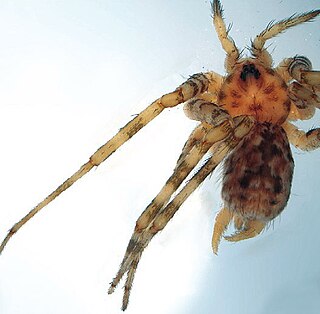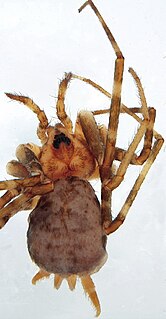
Wolf spiders are members of the family Lycosidae, from the Ancient Greek word "λύκος" meaning "wolf". They are robust and agile hunters with excellent eyesight. They live mostly in solitude and hunt alone, and do not spin webs. Some are opportunistic hunters pouncing upon prey as they find it or even chasing it over short distances. Some wait for passing prey in or near the mouth of a burrow.

Tree trunk spiders (Hersiliidae) is a tropical and semi-tropical family first described by Tamerlan Thorell in 1870. They have two prominent spinnerets that are almost as long as their abdomen, earning them the nickname "two-tailed spiders". They range in size from 10 to 18 millimetres long. Rather than using a web that captures prey directly, they lay a light coating of threads over an area of tree bark and wait for an insect to stray onto the patch. When this happens, they encircle their spinnerets around their prey while casting silk on it. When the insect is immobilized, they can bite it through the shroud.
Cedicoides is a genus of spiders in the family Cybaeidae made up of four species. It is characterized by well developed tegulum on the bulb of the male pedipalp. When it was published by Charitonov in 1946, it acted as a subgenus to Cedicus. Later, it was argued that the differences between spiders of Cedicoides and those of other subgenera - notably the presence of a terminal apophysis and the shape of the male pedipalp - were great enough to warrant a new genus. In 2003, it was upgraded from subgenus to genus status by Marusik & Guseinov. Spiders of this genus are rare, and are often missing from spider collections taken from these regions during any time other than their mating season.

Alireza Zamani is an Iranian arachnologist and taxonomist.
Sinoctenus is a monotypic genus of East Asian wandering spiders containing the single species, Sinoctenus zhui. A male was first described by Yuri M. Marusik, F. Zhang & M. M. Omelko in 2012, but no female has yet been described. It has only been found in China.
Paracedicus is a genus of Asian araneomorph spiders in the Cybaeidae family, and was first described by Victor R. Fet in 1993. First placed as a subgenus of Cedicus, it was elevated to genus status in 2003.
Pacifantistea is a monotypic genus of Asian dwarf sheet spiders containing the single species, Pacifantistea ovtchinnikovi. It was first described by Yuri M. Marusik in 2011, and has only been found in Russia and in Japan.

Deltshevia is a genus of Asian tree trunk spiders that was first described by Yuri M. Marusik & Victor R. Fet in 2009. As of May 2019 it contains only two species: D. danovi and D. gromovi.
Duninia is a genus of Asian tree trunk spiders that was first described by Yuri M. Marusik & Victor R. Fet in 2009.

Hersiliola is a genus of tree trunk spiders that was first described by Tamerlan Thorell in 1870.
Fedotovia is a genus of Asian ground spiders that was first described by Dmitry Kharitonov in 1946.
Arcterigone is a monotypic genus of dwarf spiders containing the single species, Arcterigone pilifrons. It was first described by K. Y. Eskov & Y. M. Marusik in 1994, and has only been found in Canada, and in Russia.
Pacifiphantes is a genus of dwarf spiders that was first described by K. Y. Eskov & Y. M. Marusik in 1994. As of May 2019 it contains only two species, both found in the United States, Canada, Russia, China, and Korea: P. magnificus and P. zakharovi.
Paratmeticus is a monotypic genus of Asian dwarf spiders containing the single species, Paratmeticus bipunctis. It was first described by Y. M. Marusik & S. Koponen in 2010, and has only been found in Russia and Japan.
Parawubanoides is a monotypic genus of Asian dwarf spiders containing the single species, Parawubanoides unicornis. It was first described by K. Y. Eskov & Y. M. Marusik in 1992, and has only been found in Russia and Mongolia.
Perlongipalpus is a genus of Asian dwarf spiders that was first described by K. Y. Eskov & Y. M. Marusik in 1991.
Pseudowubana is a monotypic genus of Asian sheet weavers containing the single species, Pseudowubana wagae. It was first described by K. Y. Eskov & Y. M. Marusik in 1992, and has only been found in Mongolia and Russia.
Sibirocyba is a monotypic genus of Asian sheet weavers containing the single species, Sibirocyba incerta. It was first described by K. Y. Eskov & Y. M. Marusik in 1994, and has only been found in Russia and Siberia.
Silometopoides is a genus of sheet weavers that was first described by K. Y. Eskov in 1990.
Zerogone is a genus of spiders in the Linyphiidae family. It was first described in 1994 by Eskov & Marusik. As of 2017, it contains only one species, Zerogone submissella.








